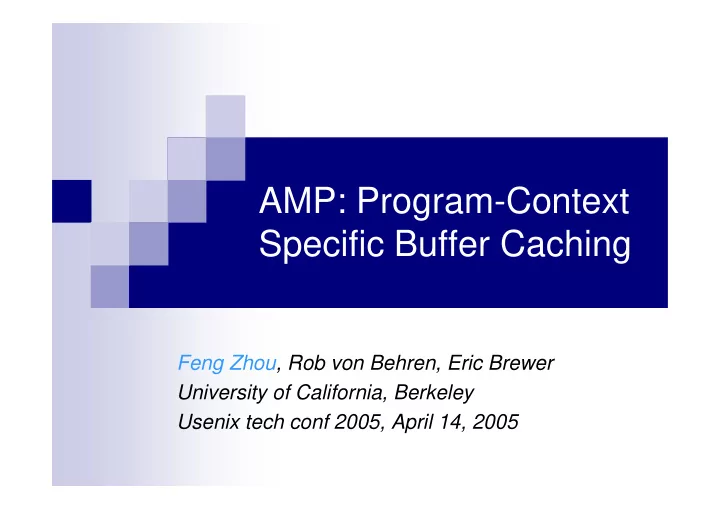

AMP: Program-Context Specific Buffer Caching Feng Zhou, Rob von Behren, Eric Brewer University of California, Berkeley Usenix tech conf 2005, April 14, 2005
Buffer caching beyond LRU � Buffer cache speeds up file reads by caching file content � LRU performs badly for large looping accesses 2 3 4 miss 1 1 2 3 4 , Cache Size: 3 Access stream: 0 Hit Rate for any loop over data set larger than cache size � DB, IR, scientific apps often suffer from this � Recent work � Utilizing frequency: ARC (Megiddo & Modha 03), CAR (Bansal & Modha 04) � Detection: UBM (Kim et al. 00), DEAR (Choi et al. 99), 2 PCC (Gniady et al. 04)
Program Context (PC) � Program context: current program counter + all return addresses on the call stack #1 #2 #3 btree_index_scan() btree_tuple_get(key,…) process_http_req(…) get_page(table, index) send_file(…) foo_db bar_httpd read(fd, buf, pos, count) Ideal policies #1: MRU for loops #2, #3: LRU/ARC for all others 3
Contributions of AMP � PC-specific organization that treats requests from different program contexts differently * � Robust looping pattern detection algorithm � reliable with irregularities � Randomized partitioned cache management scheme � much cheaper than previous methods * Same idea is developed concurrently by Gniady et al (PCC at OSDI’04) 4
Adaptive Multi-Policy Caching (AMP) fs syscall()/page fault calc PC (block,pc) detect pattern using time to detect? info about past requests from same PC (pattern) (block,pc,pattern) Default partition (LRU/ARC) go to cache partition using MRU1 buffer appropriate cache MRU2 policy …… 5
Looping pattern detection � Intuition: � Looping streams always access blocks that has not been accessed for the longest period of time, i.e. the least recently used blocks. 1 2 3 1 2 3 � Streams with locality (temporally clustered streams) access blocks that has been accessed recently, i.e. recently used blocks. 1 2 3 3 4 3 4 � What AMP does: measure a metric we call average access recency of all block accesses 6
Loop detection scheme � For the i -th access � L i : list of all previously accessed blocks, ordered from the oldest to the most recent by their last access time. � p i : position in L i of the block accessed ( 0 to | L i |-1 ) � Access recency: R i =p i / (| L i |-1) p i / (| L i |-1) 1 0 R i = L i : oldest most recent 7
Loop detection scheme cont. � Average access recency R = avg( R i ) � Detection result: � loop , if R < T loop (e.g. 0.4) � temporally clustered , if R > T tc (e.g. 0.6) � others , o.w. (near 0.5) � Sampling to reduce space and computational overhead 8
Example: loop � Access stream: [1 2 3 1 2 3] block i L i p i R i 1 1 empty 2 2 1 3 3 1 2 4 1 1 2 3 0 0 5 2 2 3 1 0 0 6 3 3 1 2 0 0 � R =0, detected pattern is loop 9
Example: non-loop � Access stream: [1 2 3 4 4 3 4 5 6 5 6], R =0.79 block i L i p i R i 1 1 empty 2 2 1 3 3 1 2 4 4 1 2 3 5 4 3 1 1 2 3 4 6 3 2 0.667 1 2 3 4 7 4 2 0.667 1 2 4 3 8 5 1 2 3 4 9 6 1 2 3 4 5 10 5 4 0.8 1 2 3 4 5 6 11 6 0 0.8 1 2 3 4 6 5 10
Randomized Cache Partition Management � Need to decide cache sizes devoted to each PC � Marginal gain (MG) � the expected number of extra hits over unit time if one extra block is allocated � Local optimum when every partition has the same MG � Randomized scheme � Expand the default partition by one if ghost buffer hit � Expand an MRU partition by one every loop_size / ghost_buffer_size accesses to the partition � Expansion is done by taking a block from a random other part. � Compared to UBM and PCC � O(1) and does not need to find smallest MG 11
Robustness of loop detection AMP tc loop loop tc loop loop other R 0.755 0.001 0.347 0.617 0.008 0.010 0.513 DEAR other loop other other loop other other PCC loop loop loop loop loop other loop “tc”=temporally clustered Colored detection results are wrong Classifying tc as other is deemed correct. 12
Simulation: dbt3 (tpc-h) Reduces miss rate by > 50% compared to LRU/ARC Much better than DEAR and slightly better than PCC* 13
Implementation � Kernel patch for Linux 2.6.8.1 � Shortens time to index Linux source code using glimpseindex by up to 13% (read traffic down 43%) � Shortens time to complete DBT3 (tpc-h) DB workload by 9.6% (read traffic down 24%) � http://www.cs.berkeley.edu/~zf/amp � Tech report � Linux implementation � General buffer cache simulator 14
Recommend
More recommend